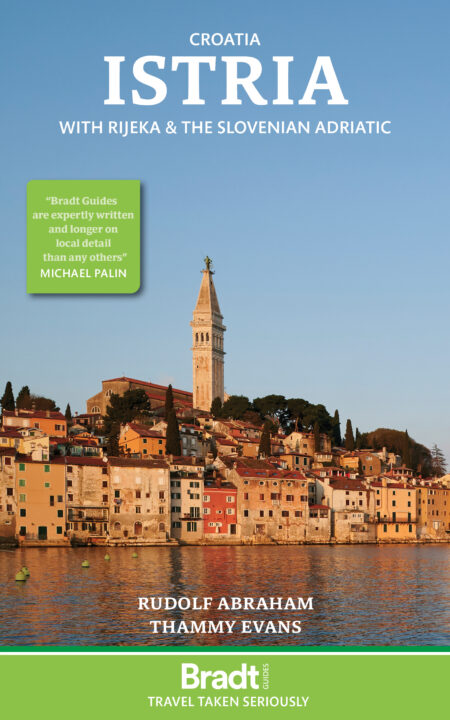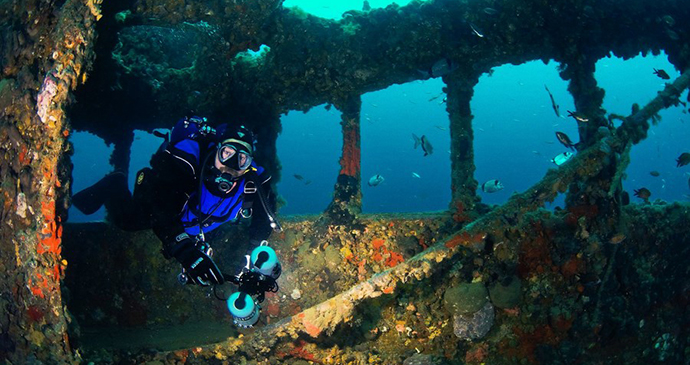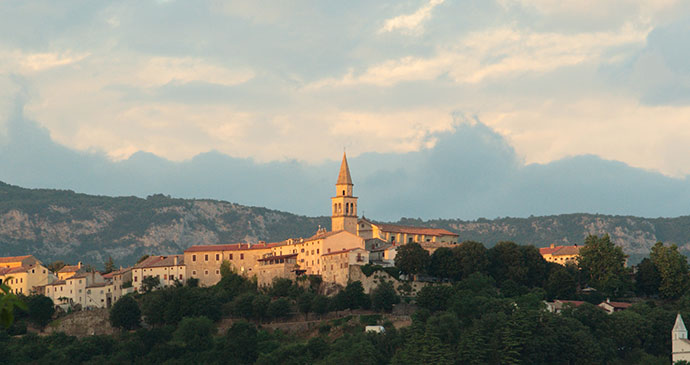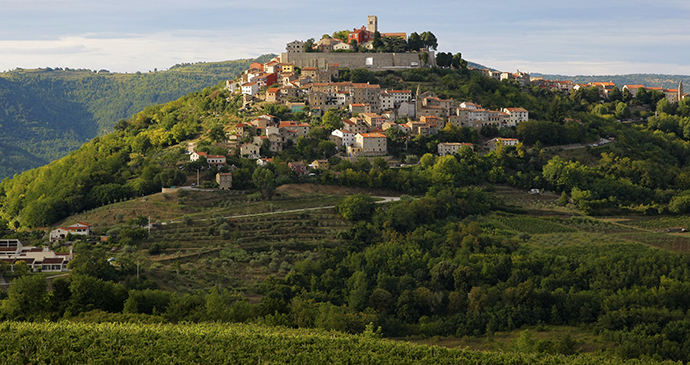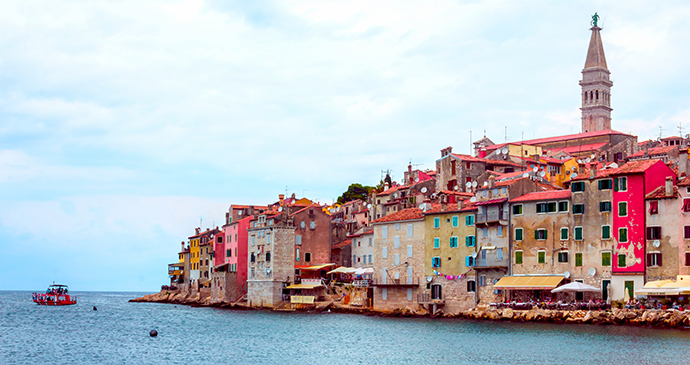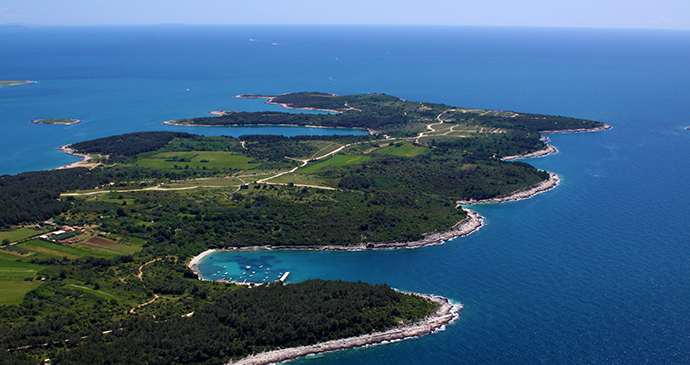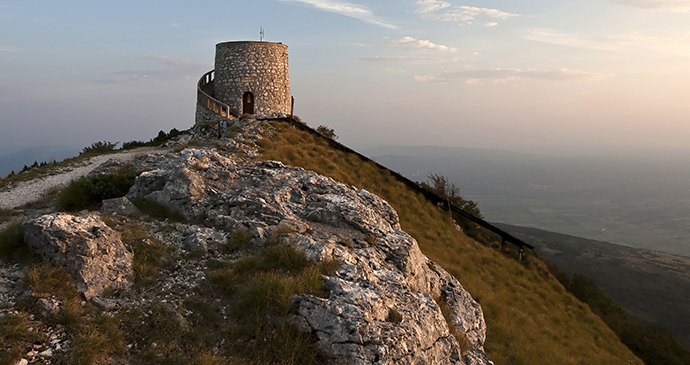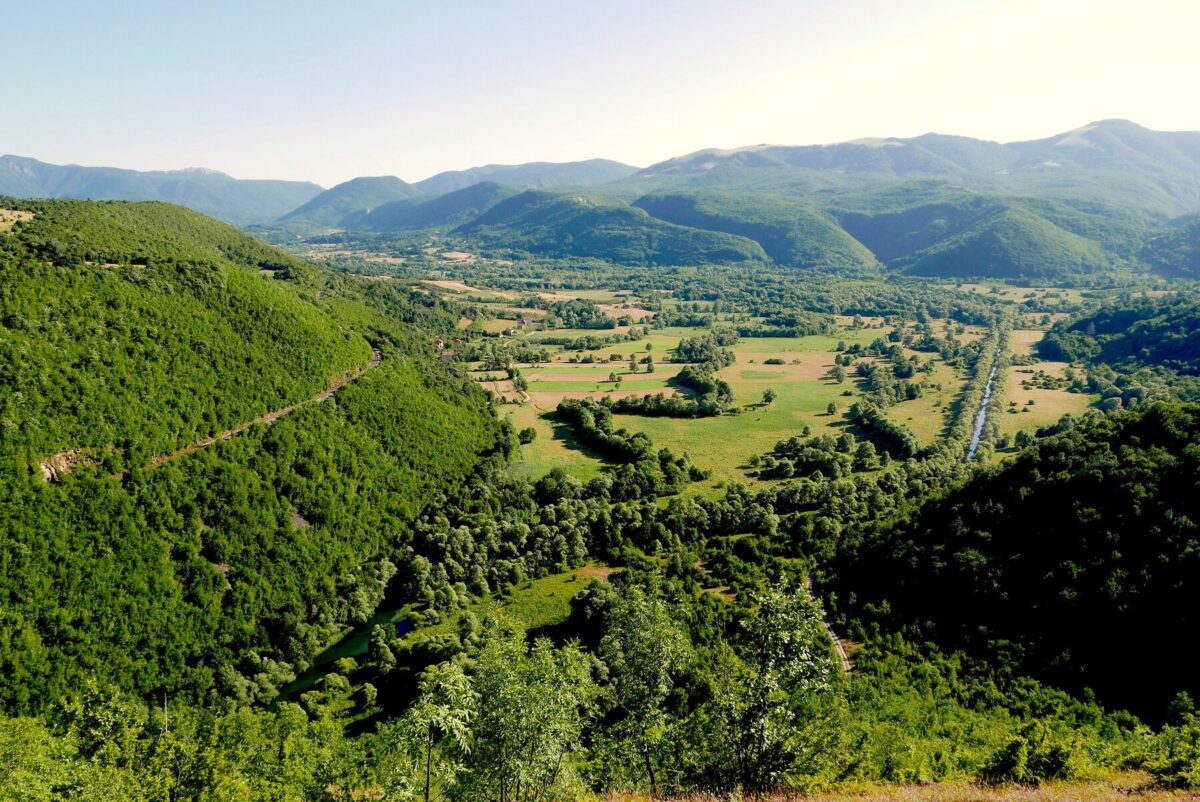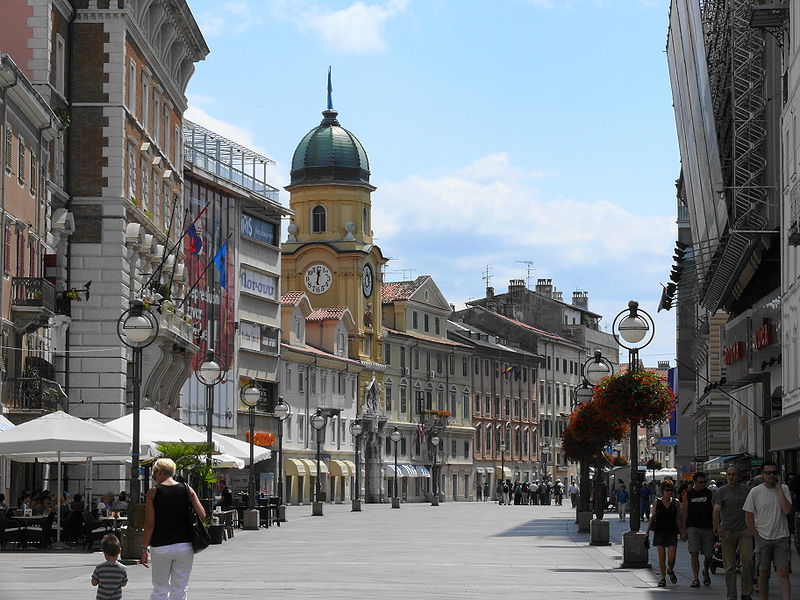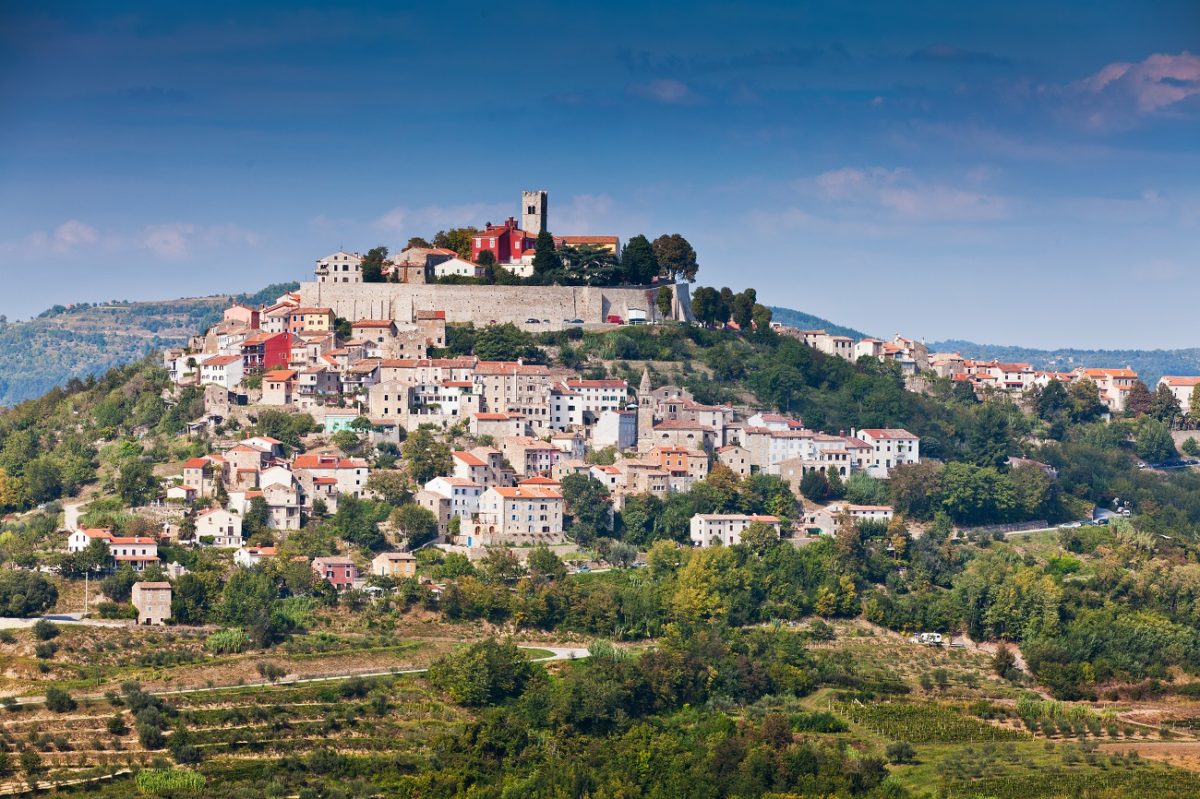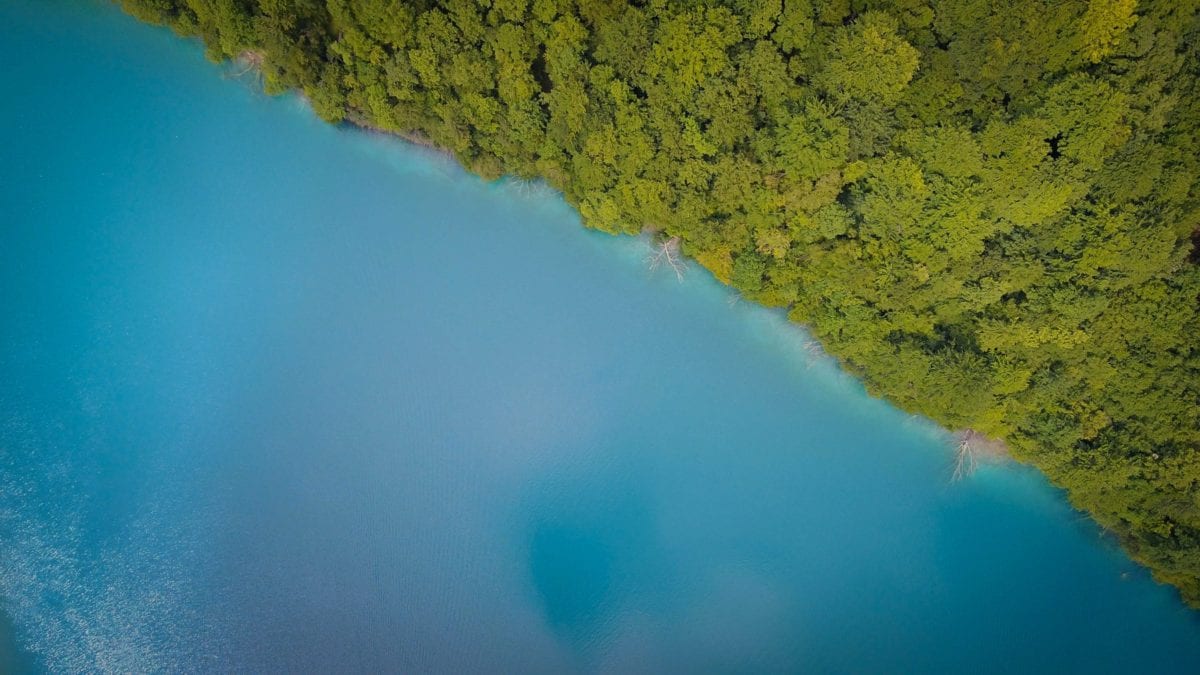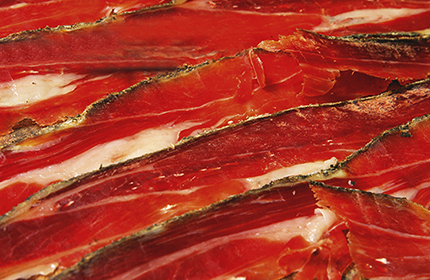Despite its diminutive size, the peninsula packs in so much, ticking boxes for those seeking outdoors activities, culture, gastronomy, history or just rest and relaxation.
Rudolf Abraham, author of Istria: The Bradt Guide
Perched at the top of the Adriatic, where the Croatian and Slovenian coasts meet, Istria is a compact destination, ideal for short breaks. Despite its diminutive size, the peninsula packs in so much, ticking boxes for those seeking outdoors activities, culture, gastronomy, history or just rest and relaxation.
An enchanting starting point is Rovinj, where a stroll through its narrow streets can be punctuated by al fresco coffee and dining breaks. Istria’s past is on display around every corner but the showstoppers are Pula’s huge amphitheatre and the UNESCO-listed Byzantine mosaics in Poreč. Be sure to venture inland and uphill to gaze out over rolling vineyards from settlements like Grožnjan, Hum and Motovun.
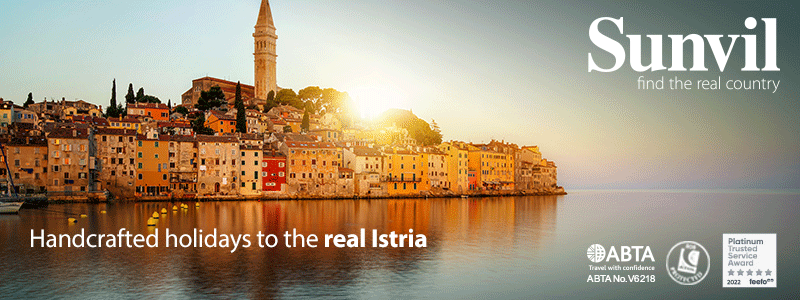
If you want an active element to your holiday then Istria doesn’t disappoint. Its blue seas make swimming, sailing and diving irresistible. Hiking routes range from scenic strolls to demanding mountain treks.
Those who favour two wheels will also feel at home, especially on the off-road route along the old Parenzana narrow-gauge railway. And then there’s the food – what the coast delivers in fresh fish and seafood, the inland area answers with truffles, olives, game and dry-cured pršut. All sorts of idiosyncratic festivals put a quirky spin on visits – from world-class film screenings in Pula and Motovun, to Lovran’s celebrations of wild asparagus, chestnut and cherry.
Istria’s location makes it a great base for day trips to nearby Rijeka. It’s also highly recommended to hop over the border to Slovenia’s coastal towns, like Koper and Piran, and inland sites such as Postojna Cave and the Lipica stud farm.
For more information, check out our guide to Istria:
Food and drink in Istria
Food
Breakfast for many people in Istria is a fairly light affair and might just include fruit and yoghurt, and perhaps bread, cheese and ham – though hotels usually offer a more substantial buffet-style continental or cooked breakfast. Otherwise, buying a pastry from a bakery and sitting outside a café to eat it while you drink your coffee is quite acceptable (providing the café doesn’t serve food).
For most people, lunch is the main meal of the day, often starting with soup of some kind or another (most traditionally, maneštra), followed by meat or fish, with homemade pasta possibly being served in between this and the soup, or replacing the main course. Dinner is again lighter, at least when eating at home.
Seafood is very popular, especially along the coast, with freshly caught gilthead bream and sea bass jostling for position on the menu with shellfish from the Limski kanal, lobster, mackerel, octopus, either roasted, or served as a cold salad made with potato, olive oil, garlic and parsley), ‘black’ risotto with cuttlefish, and fish stew. Grilled fish is traditionally served with boiled potatoes and Swiss chard (blitva), drizzled with olive oil, garlic and parsley.
Meat is as popular in Istria as it is elsewhere in Croatia, from the proverbial roštilj (mixed grill) to tender beef carpaccio. The boškarin or native Istrian ox is considered a great delicacy. Game is often found on the menu in Istria, either venison or wild boar, the latter being fairly widespread in the Ćićarija Mountains, where it is hunted. Fuži (a traditional type of Istrian pasta) with a sauce of wild game is fantastically rich and highly recommended. Istria is also renowned for its excellent pršut (dry-cured ham, similar to Italian prosciutto), especially that produced around the village of Tinjan.
Vegetarians may find Istria slightly easier to travel in than some other parts of Croatia, with plenty of pasta and truffle dishes to choose from, and salads – although here, as elsewhere in Croatia, fish, sausages or even turkey might not be considered ‘meat’ by some. Fruit and vegetables are plentiful, from wild asparagus (in season during spring) to corn, figs, chestnuts and cherries.
Drinks
Istria produces some exceptionally good wine, some of which might be counted among the best in Croatia. Istria’s signature grape is Malvazija (though it is not unique to Istria, with other varieties growing elsewhere in the Mediterranean), a lovely crisp white with hints of acacia, while its best-known red is the autochthonous Teran – though Chardonnay, Cabernet Sauvignon, Merlot and several other varieties are also produced, including Refošk (Italian Refosco, as grown in the Veneto). Many vineyards offer tastings and degustations, and can also sell wine by the litre if you turn up with your own empty plastic bottles.
A traditional Istrian drink is supa, red wine (usually Teran) heated with olive oil, sugar and pepper, and served in a bukaleta (traditional pottery jug) with slices of toasted bread on top. Istria’s local brand of beer is Favorit, which is brewed on the outskirts of Buzet. Croatian beers are cheap, whether on tap or bottled, though imported beers cost more. Rakija, a potent local spirit, comes in several guises including loza (made with grapes, and similar to grappa), šljivovica (made with plums) and the deceptively easy-to-drink medovača (rakija with a smidgen of honey to take the edge off).
The coffee in Istria is almost always excellent, and you’ll never be far away from a café with tables spilling out on to the street, or a pleasant terrace, perhaps overlooking the sea or in the shade of ancient chestnut trees.
Health and safety in Istria
Health
Istria has reasonable health services and some good private doctors. There is a hyperbaric chamber for diving-related accidents at Pula. All the major towns have some hospital services, with Pula being the main hospital for Istria. Larger facilities are available in Rijeka, with the country’s best services of course in Zagreb. From Slovenia, the best services are in Ljubljana. Croatia already has very good public health services for tourists, which are available at most hospitals. Travellers from the EU and Switzerland can use their EHIC in Croatia to access free or discounted public healthcare in Croatia – UK nationals currently just need to show their passports to access free emergency treatment in a hospital; however, this may well change when the UK leaves the EU. Private healthcare is not included, nor is the cost of repatriation or routine monitoring of pre-existing conditions, therefore additional health insurance is still strongly recommended.
Safety
Female Travellers
Sexual harassment is not usually a problem in Istria and it is not considered strange to be a woman traveller on your own. Dress for women here is as in the rest of western Europe, but take care not to be in swimwear or skimpy attire in churches.
LGBTQ+ travellers
The gay and lesbian scene is very limited in Istria although it is more accepted throughout Croatia and Slovenia than in other parts of former Yugoslavia. This said, the most popular gay resort this side of Zagreb is Rovinj. Whilst the town itself may not offer much overtly to the gay and lesbian visitor, Punta Križa Beach north of Rovinj town, between Amarin and Valalta campsites, is the renowned gay mecca. As an extension of the Valalta nudist camp, it is full of bronzed males perfecting every last inch of their tan.
Travellers with disabilities
Istria is not so easy to get around for those with mobility problems, in part because of a lack of public transport in small towns and because of the steep cobbled streets in most of the seaside towns, and the hill towns of the Istrian interior. Poreč, being at least more flat, is easier to get around. Disabled car-parking spaces are common, however. Pula airport has ramps until you enter the plane itself. For the blind or partially sighted, there is little assistance. Modern hotels, and those of the large conglomerates are more accustomed to clients with mobility problems and do have some specially fitted rooms, at least with walk-in showers.
Travelling with children
Istria, being Mediterranean in nature, is very tolerant of children, who will be welcome in all restaurants, and are expected to be out in the late evenings when it is cool. Croatian children, who are in nursery till they are six or seven years old, have a 2-hour siesta at nursery; hence they are all still awake at 22.00. Finding washrooms with baby-changing facilities or restaurants with high chairs is more difficult, so bring with you travel change mats and portable booster seats. Big hotel restaurants are better equipped.
Travel and visas in Istria
Visas
Nationals of EU countries no longer need a visa to stay in Croatia and Slovenia, and will merely need to show a valid form of identification such as a passport or an ID card. However, arrangements for UK nationals may change following the country’s exit from the EU. Most nationals of other countries may visit Croatia and Slovenia for up to three months within a six-month period starting from the first day of entry.
Getting there and away
By air
Istria has one international airport, at Pula, or, more accurately, 7km northeast of Pula near the village of Valtura. Rijeka also has an international airport, though it’s actually on the island of Krk so is less convenient for Istria.
By train
Rijeka is easily reached by train from Zagreb, as is Koper from Ljubljana; Pula can also be reached by train from Ljubljana, with a change at Hrpelje-Kozina.
By bus
The Istrian coast is well connected to the rest of Croatia and several international destinations by bus. Pula has buses to Trieste, Ljubljana, Belgrade and Frankfurt, while Rovinj and Poreč have services to Trieste, Ljubljana and Belgrade. Rijeka has international services to Trieste, Ljubljana and Munich, and is well connected to most places in Istria by bus. Pazin is the only place in inland Istria with international bus connections, with one service a day to Trieste, Venice and Belgrade.
By boat
During the summer, international ferry routes operate between both Trieste and Venice in Italy, and Poreč, Rovinj and Pula in Istria, as well as to Piran in Slovenia, making it quite possible to ferry-hop between several towns on the coast.
By car
Istria is easy to reach by car. For those flying in, or arriving by boat, major car-rental companies such as Europcar, Budget and Sixt are available at the main airports
serving onward travel to Istria. These also allow you to pick up in one country and drop off in another if you wish (at a cost).
Getting around
By train
Train travel within Istria is limited to the Pula–Pazin line, which continues to Lupoglav and then north to Slovenia. Rail fares are very reasonable in Croatia, eg: Pula–Pazin costs 37kn. A return ticket will be cheaper than two singles, and two people travelling together can get a joint ticket, which is slightly cheaper but means you must travel together.
By bus
Bus is the most convenient means of public transport in Istria, with frequent, fast services between all main centres on the coast. Pazin also has a good, fairly regular bus timetable, but most other places in inland Istria do not (most notably Motovun, despite being by far the most visited town in the Istrian interior).
By boat
Travelling by ferry is a lovely way to get around the Croatian coast, and tickets for foot passengers are a bargain (although if you’re taking a car on the ferry it’s another matter).
By car
Istria is very easy to get around by car, and the peninsula has been on a tarmacking spree in recent years with many roads in the interior also being upgraded from the old dirt tracks (though some of the smaller minor roads still are dirt tracks, called makadamska cesta or bijela cesta). Istria’s only motorway, known locally as the ipsilon because of its ‘y’ shape, is a toll road like all motorways in Croatia.
When to visit Istria
The best times to visit Istria are undoubtedly spring and autumn: it’s warm during the day, cool in the evening and the madding crowds of summer are absent. It’s sunny almost all year round, and even the winter sun brings warmth. Even in winter, cafés often have outside terraces open for customers to benefit from the sun’s rays (and of course for smokers since smoking inside was banned although, in winter, you might just find everybody smokes inside). T-shirt weather – at least during the main part of the day – can start as early as March and go into October.
Cyclists wanting to take advantage of the lack of people on the roads combined with beautiful sunny days often come as early as February and as late as November. July and August are hot – usually over 30°C – and very busy with tourists (at least along the coast), but for those with families, this is of course the only time they can take their summer holidays.
What to see and do in Istria
Exploring the wreck © Filip Višić
Baron Gautsch wreck
Built in Scotland’s Dundee shipyard by Gourlay Brothers & Co, this Austro-Hungarian passenger steamship was launched in 1908 and became the pride of the Austro-Hungarian shipping fleet Austrian Lloyd (today’s Italia Marittima) based in Trieste. It sailed the Trieste–Kotor route (in Montenegro), and was leased by the Austro-Hungarian navy in World War I to transport military personnel to Kotor. On a return trip on 13 August 1914, laden with civilian passengers and refugees, the ship hit a mine and sank west of the Brijuni Islands. The wreck is a war grave, and has been looted extensively in previous years. After more than 100 years, the wreck today is quite decayed but the overall structure retains its shape. It is marked by a buoy and, as visibility can be low, descent and decompression is by the buoy line. This can get busy in the summer.
Buzet is one of interior Istria’s hidden gems © mina, Shutterstock
Buzet
Perched on a hill and overlooking the truffle-rich Mirna Valley on one side and the forested slopes of the Ćićarija Mountains on the other, Buzet (Italian Pinguente) is, for one of the authors at least, the most rewarding of the Istrian hill towns – with colourful festivals, great hiking and biking opportunities in the surrounding hills and valleys, and a wealth of cultural interest in nearby towns and villages. There’s even a good bus service to Rijeka and Zagreb. Nevertheless, Buzet receives much less attention and fewer visitors than Motovun and Grožnjan further west. Often called the ‘City of Truffles’, there are two big truffle events in its annual calendar, and Istria’s favourite local beer, known appropriately enough as Favorit, is brewed here.
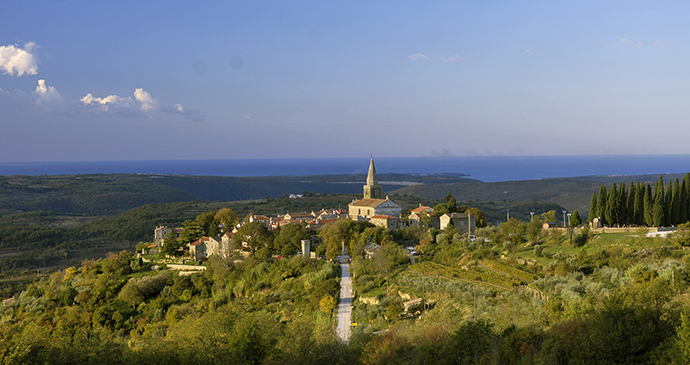
Grožnjan
Grožnjan (Italian Grisignana) is, like Motovun, one of the more popular of the Istrian hill towns, helped no doubt by its relative proximity to the northwest coast. It is a pretty little town, with a well-preserved old medieval centre and fine views over the Mirna Valley. Despite having been left largely deserted after the Italian exodus that followed World War II, the municipality of Grožnjan today has a higher proportion of people describing Italian as their first language than anywhere else in Istria. Artists in particular were encouraged to move to the largely depopulated town from the late 1960s onwards, and today the self-styled ‘Town of Artists’ is full of little galleries and boutique shops selling art, handmade jewellery, wine, olive oil, etc. Full being a relative term, of course – Grožnjan, like other Istrian hill towns, is still a fairly sleepy place, and has fewer than 100 inhabitants.
The famous view of Motovun, emblematic of Istria’s interior © Istra Photonet
Motovun
Motovun (Italian Montona), without any doubt the best-known and most photographed of central Istria’s hill towns, sits atop a 277m flat-topped hill on one side of the Mirna Valley. Once the site of a prehistoric hill fort, and a Roman settlement from at least the late 2nd century AD, when clay was extracted from the surrounding area for the production of amphorae, Motovun is first mentioned in a historical document from 804. The main thing to see in Motovun is the town itself – a walled Gothic and Renaissance citadel draped across the top of a flat-topped hill.
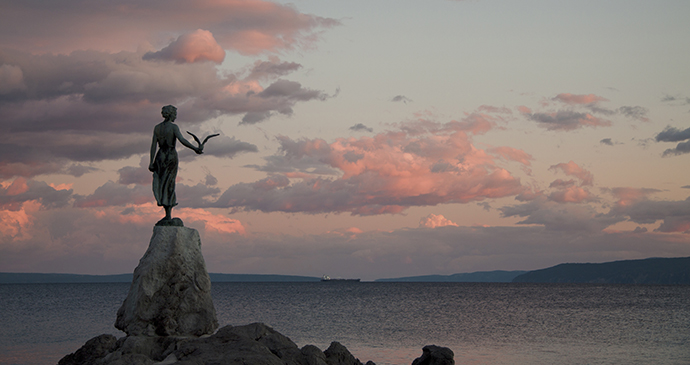
Opatija
A mere fishing village 200 years ago, Opatija became the first spa resort on the entire Croatian coast. Largely only for the rich, privileged and noble 150 years ago, it still has, as a result, what must be the highest concentration of high-end spa hotels in Croatia, especially for its size. These hotels and villas alone are worth a stroll along the 12km promenade. Opatija hides a few more gems, including its botanical gardens Benedictine abbey of St James, the medieval fort at Veprinac and – just a short stroll along the coast at one end of that lovely promenade – the pre-eminent gastro-enclave anywhere in Croatia, at the sleepy little fishing village of Volosko.
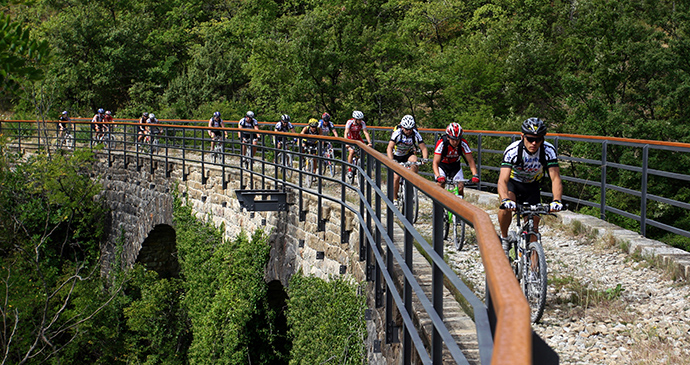
Parenzana cycle route
The Parenzana was a 123km-long narrow-gauge railway line between Trieste and Poreč, which ran from 1902 to 1935 and connected some 35 stations in Istria, and spanned what is now Italy, Slovenia and Croatia. It was used to carry both passengers and freight – olive oil, fl our, vegetables, wine, hides, salt from Piran, lime, and stone – navigating the hilly karst landscape between remote villages via a series of tunnels, bridges and viaducts.
In 2002, on the 100th anniversary of its opening, the old Parenzana line was developed into a cycling and hiking route, beginning with sections in Croatia and Slovenia and later the whole line. By far the longest section of the Parenzana is in Croatia (78km, compared with 32km in Slovenia and 13km in Italy), and among the towns and villages it connects between Poreč and the Slovenian border are Buje, Grožnjan, Oprtalj, Motovun, Vižinada, and Nova Vas. Over its history the Parenzana has had several names – to its Austrian builders it was the Parenzaner Bahn, to the Italians it was the Parenzana, in abbreviation it became TPC, and to the local population it was the Istrijanka or Istranka (or sometimes Poreška or Porečanka – after the town of Poreč, known as Parenzo in Italian).
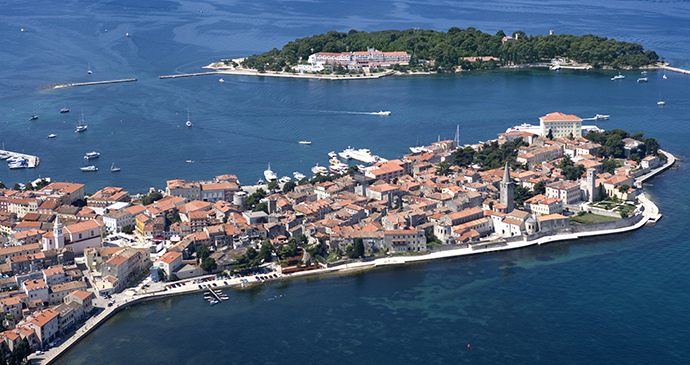
Poreč
Poreč itself has a beautiful and quite typical Croatian coastal old town centre, jutting like a small island into the sea, and is home to renowned 6th-century BC mosaics in its UNESCO World Heritage Site basilica. Back in Roman times Poreč was the capital of Istria. Today it retains a life of its own year-round, unlike the more highly praised Rovinj, which burgeons in the summer and is deserted in the winter. Poreč life picks up as early as the end of February, when the first of the cycling enthusiasts come to take advantage of the mild weather and light traffic on Istrian roads. And while beach facilities might close in mid-October, outdoor-sports types, especially divers, will stay into early November, when the water can retain a wonderful 18°C temperature, often warmer than the outside air. Poreč’s old town is a testament to Roman military planning. Awash with souvenirs and ice cream, the side streets hide crafts and art exhibitions, sales of local rakija from house doorways, and the odd hidden café.
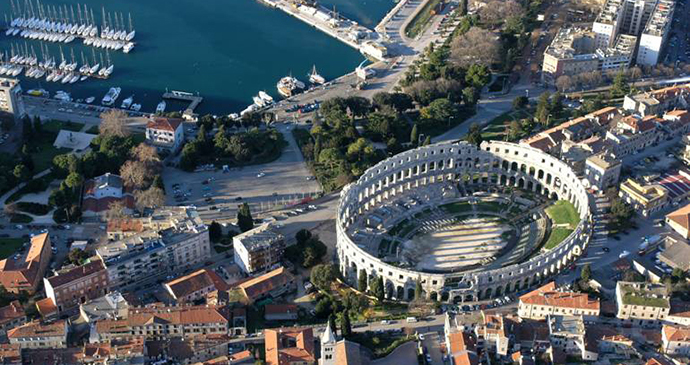
Pula
Located towards the southern tip of the Istrian Peninsula, Pula often (quite undeservedly) receives less attention than neighbouring Rovinj and Poreč. Yet it is a thriving city, as becomes the largest urban area and economic centre of Istria, with some of the finest Roman ruins anywhere in Croatia – most spectacular among these is its huge amphitheatre. There are popular beaches south of the centre at Medulin, Premantura and Stoja, cosy bars in town where you can acquaint yourself with a variety of local wines or listen to live jazz, a terrific open market, and Istria’s main archaeological museum.
Pula’s amphitheatre was probably built during the first few years of the 1st century ad, during the reign of the emperor Augustus, and was completed in its present form under Vespasian (AD69–79), making it roughly contemporary with Rome’s Colosseum. It is one of the six largest surviving Roman amphitheatres in the world, slightly elliptical in plan and measuring some 132m x 105m, with an estimated capacity of around 20,000 spectators. Its remarkably intact outer walls reach a height of some 32m, with two tiers of arches surmounted by a third tier of rectangular apertures, and on the landward side (where the ground level is higher), only two levels. The walls also incorporate four towers, each with a spiral staircase that gave access to the seating areas, and with a water storage tank (supplied by an aqueduct), from which water was then distributed around the arena by channels. The underground passages, through which unfortunate gladiators once made their way into the arena to undertake bloody, mortal combat, now hold an exhibition of wine and olive oil production in Roman Istria. The arena itself now holds major concerts and operas, and some screenings of the Pula Film Festival, with seating for 5,000–8,000. It stands just outside the city walls on Flavijevska or Via Flavia, formerly the Roman road leading to Poreč and Trieste.
Rovinj’s Venetian old town sits on the waterfront © Littleaom, Shutterstock
Rovinj
For many, Rovinj is the pearl and the envy of Istria. Favoured by the Venetians when it was ruled by the Republic of Venice, it was also a favourite of the touristing classes of the Austro-Hungarian Empire. The colourful hues of Rovinj’s houses hail from these influences, especially the dominant Venetian red. Often overwhelmed with visitors in the height of summer – when it’s popular with tours from Poreč and Pula, where it is easier to get accommodation – in the winter it is almost deserted. The tightly packed houses of Rovinj’s old town form some of the narrowest of cobbled streets, which pop out atop the hill of the once-upon-a-time island to a magnificent vista from the generously wide courtyard of the equally generously endowed St Euphemia Church. Being so popular, the town understandably has a couple of Istria’s best restaurants, festivals and enviable bars.
Rt Kamenjak stretches out into the Adriatic © Igor Karasi, Shutterstock
Rt Kamenjak
Rt Kamenjak meanders out into the waters of the Adriatic between Medulin and Banjole – a slender, highly indented peninsula that constitutes the southernmost tip of Istria. The southern half of Rt Kamenjak is one of the most beautifully unspoilt stretches of coastline anywhere in Croatia, and is a nature reserve. Some 530 plant species have been recorded on Kamenjak, including at least 28 species of orchid, many of them classified as rare or endangered and two of them endemic to the southern part of Istria; there are numerous butterfly species; and one of the only sightings of the Critically Endangered Mediterranean monk seal in Croatia in recent decades was in these waters – an animal now reduced to only around 600 individuals. There are also dinosaur footprints on the rocky northwest coast of Kamenjak, with an educational trail and dinosaur models – great fun for kids.
The Kula on Vojak, Učka’s highest peak © Istra Photonet
Učka Nature Park
Učka Nature Park or Park prirode Učka stretches southwest from Opatija, parallel with and just inland from the coast, and covers an area of around 160km². It is one of 11 nature parks in Croatia – the only one in Istria – and includes the Učka massif as well as part of neighbouring Ćićarija. Fauna ranges from wild boar and roe deer to endemic subterranean cave beetles and endemic land snails, and around 250 species of butterflies and moths.
The highest point on Učka, Vojak (also known as Vrh Učka), rises to just over 1,400m above sea level, and is crowned by a stout stone tower, as well as a paragliding ramp just below this – not to mention a gigantic telecommunications aerial, but don’t let that put you off. The surrounding slopes are lushly forested, punctuated by the occasional meadow as well as some stark areas of limestone scenery, including the knobbly fingers of rock protruding from Vranjska draga, close to the inland entrance to the Učka tunnel.
Related books
For more information, see our guide to Croatia (Istria):
Related articles
In this extract from her book, My Family and Other Enemies, Mary Novakovich recalls meeting family in Croatia for the first and only time.
Home to grand Secessionist architecture, broad pedestrian streets and excellent restaurants, Rijeka is well-deserving of its reputation as Croatia’s cultural capital.
Enter a world of perfectly preserved medieval hill towns, hidden frescoes and heavenly food.
There are many national parks in Europe that remain fairly unknown. Here you can discover 14 of the best. Why miss out on visiting somewhere spectacular?
One of the best reasons to visit Istria is the region’s outstanding cuisine.
